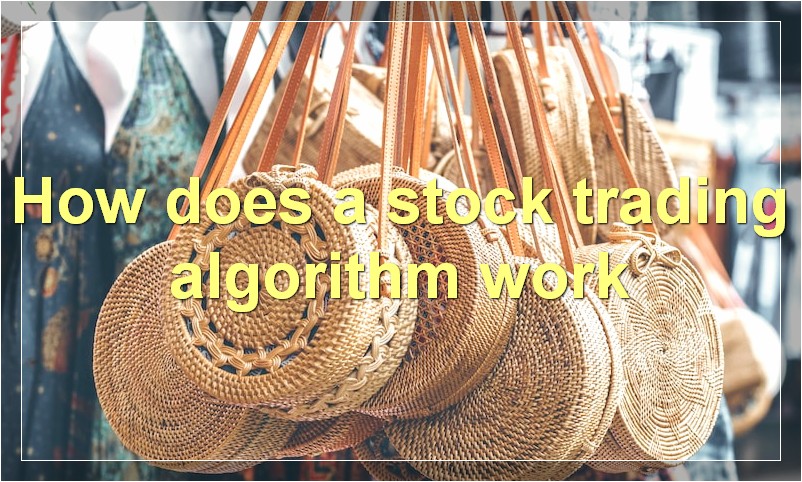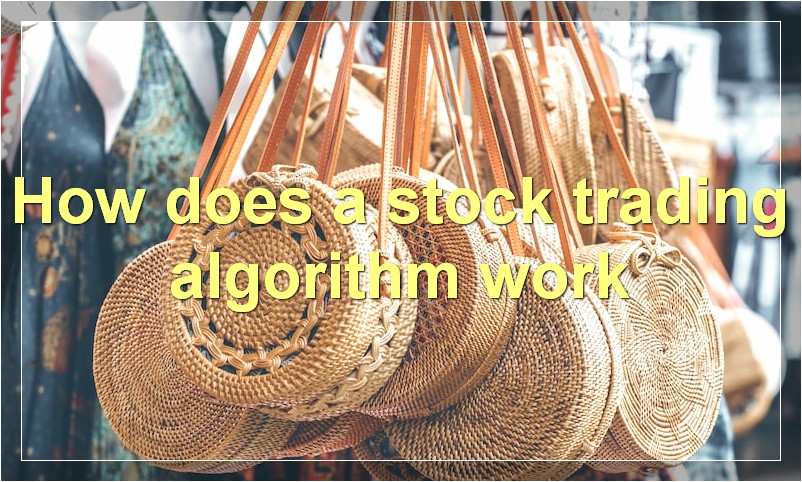If you’re thinking about getting into stock trading, then you need to know about algorithms. Algorithms are what make stock trading possible, and they’re also what can help you make money – or lose it. In this article, we’ll give you everything you need to know about stock trading algorithms.
What is a stock trading algorithm
A stock trading algorithm is a computer program that makes buy or sell decisions in the stock market based on a set of predetermined rules. These algorithms are designed to remove emotion from the decision-making process and make trade decisions based on objective criteria.
Stock trading algorithms have become increasingly popular in recent years as more and more traders look for ways to take advantage of the efficiency and accuracy that these programs can provide. Algorithmic trading is now responsible for a large majority of all trades taking place on U.S. stock exchanges.
There are many different types of stock trading algorithms, each with its own set of rules and objectives. Some common examples include:
Momentum-based algorithms: These programs buy stocks that are rising in price and selling stocks that are falling in price. The goal is to ride the momentum of the market and profit from short-term price movements.
Mean reversion algorithms: These programs buy stocks that are undervalued by the market and sell stocks that are overvalued by the market. The goal is to profit from the eventual return of prices to their historical averages.
Arbitrage algorithms: These programs exploit differences in prices between different markets to make profits. For example, an arbitrage algorithm might buy a stock on one exchange where it is underpriced and simultaneously sell it on another exchange where it is overpriced.
Stock trading algorithms can provide a number of benefits for traders, including improved execution speed, reduced transaction costs, and the ability to backtest strategies before committing capital. However, it is important to remember that these programs are not infallible and that losses can still occur.
How does a stock trading algorithm work

A stock trading algorithm is a computer program that makes decisions about when to buy or sell stocks based on a set of rules. These rules can be based on anything from technical indicators to market trends.
Algorithmic trading has become increasingly popular in recent years as more and more traders look for ways to take advantage of the speed and accuracy of computers. Algorithmic trading is used by large institutional investors, such as hedge funds and investment banks, as well as individual investors.
There are a number of benefits to using an algorithmic trading system. First, it can help you make faster and more informed decisions about when to buy or sell stocks. Second, it can help you manage your risk by automatically placing stop-loss orders and setting limit prices. Finally, it can help you save time by automating the process of monitoring the markets and making trades.
What are the benefits of using a stock trading algorithm
There are a number of benefits to using a stock trading algorithm. One of the most important benefits is that it can help to take the emotion out of trading. This is because the algorithm will make decisions based on objective criteria, rather than on emotions. This can help to improve the accuracy of trading decisions and can also help to minimize losses.
Another benefit of using a stock trading algorithm is that it can help to speed up the process of making trades. This is because the algorithm can quickly identify opportunities and execute trades in a very short period of time. This can be a significant advantage for traders who want to take advantage of short-term market movements.
Finally, using a stock trading algorithm can also help to reduce costs. This is because algorithms can often execute trades at a lower cost than human traders. This can be an important consideration for traders who are looking to minimize their trading costs.
What are the risks of using a stock trading algorithm
There are a few risks to consider before using a stock trading algorithm. First, if the market conditions change, your algorithm may no longer be effective. Second, your algorithm may give you false signals, leading you to make bad trades. Finally, if you don’t properly test your algorithm, you may end up losing money.
Are there any alternatives to using a stock trading algorithm
If you’re interested in stock trading, you might be wondering if there are any alternatives to using a stock trading algorithm. After all, algorithms can be expensive and complicated, so it’s understandable that you might want to explore other options.
Here are a few potential alternatives to using a stock trading algorithm:
1. Hiring a financial advisor: This is a great option if you want personalized attention and advice when it comes to your finances. A financial advisor can help you develop a investment strategy that meets your individual needs and goals.
2. Investing in mutual funds: Mutual funds are another popular option for those who want to invest in the stock market without having to directly manage their own portfolio. With a mutual fund, you’ll pool your money with other investors and entrust a professional manager to handle the fund’s investments.
3. Putting your money into index funds: Index funds are similar to mutual funds in that they allow you to invest in a basket of stocks without having to pick and choose individual securities. However, index funds typically have lower fees than mutual funds, making them a more cost-effective option.
4. Buying individual stocks: If you’re comfortable research companies and managing your own investments, buying individual stocks may be a good option for you. This approach gives you the most control over your portfolio but also requires the most work on your part.
No matter which option you choose, be sure to do your research and understand the risks involved before making any final decisions.
How can I create my own stock trading algorithm

In order to create your own stock trading algorithm, you will need to have a strong understanding of the stock market and how it works. You will also need to be familiar with coding and backtesting. Once you have these things in place, you can begin creating your own algorithm.
The first step is to come up with a trading strategy. This will involve deciding when to buy and sell stocks. You will also need to decide how much money you want to invest in each trade. Your strategy should be based on sound analysis and not on gut feelings.
Once you have a trading strategy, you will need to backtest it. Backtesting involves using historical data to see how your strategy would have worked in the past. This is important because it allows you to see if your strategy is viable and if it has any potential flaws.
After backtesting your strategy, you can then begin coding it. This part can be tricky, but there are many resources available to help you. Once your algorithm is coded, you can then begin testing it on real data.
If everything goes well, you should then have a working stock trading algorithm that you can use to make profits in the market.
What are some common mistakes made when using a stock trading algorithm
When it comes to stock trading, there are a number of common mistakes that are often made when using an algorithm. Perhaps the most common mistake is failing to take into account the impact of fees and commissions. When you’re trading stocks, every little bit counts and these fees can quickly eat into your profits. Another common mistake is not properly testing your algorithm before using it live. If you don’t test it thoroughly, you could end up losing a lot of money very quickly. Finally, another mistake that is often made is not keeping an eye on the market conditions. The market is constantly changing and if you’re not monitoring it closely, you could miss out on some profitable opportunities.
How can I optimize my stock trading algorithm
There are a number of ways to optimize your stock trading algorithm. One way is to use historical data to test different scenarios and see which one would have been the most profitable. Another way is to use market data to develop a model of how the market works and then test different trading strategies against that model. Finally, you can use machine learning techniques to automatically find the best trading strategy for the current market conditions.
What are some common issues that can arise when using a stock trading algorithm
There are a few common issues that can arise when using a stock trading algorithm. One issue is that the algorithm may not be able to accurately predict the future movements of the markets. This can lead to losses in your portfolio. Another issue is that the stock trading algorithm may trade on your behalf without your knowledge or consent. This can lead to unwanted trades and potentially decreased profits. Finally, if you’re not careful with your settings, you may end up with a stock trading algorithm that is too aggressive and ends up losing you money.
What are some best practices for using a stock trading algorithm
There is no one-size-fits-all answer to this question, as the best practices for using a stock trading algorithm will vary depending on the specific algorithm being used. However, some general tips that can be followed when using any stock trading algorithm include:
– ensuring that the algorithm is tested and verified before live trading is attempted
– starting with small trade sizes and gradually increasing them as confidence in the algorithm grows
– monitoring the performance of the algorithm on an ongoing basis and making tweaks as necessary
following these best practices should help to ensure that using a stock trading algorithm is a successful and profitable endeavor.

